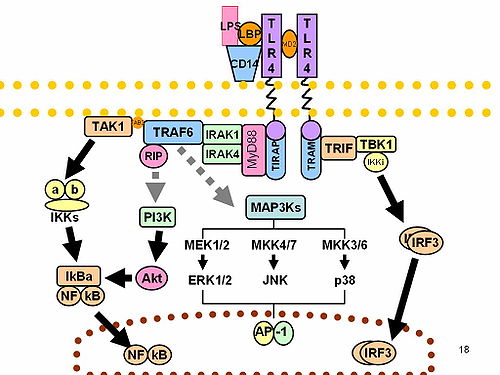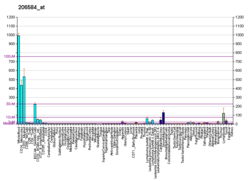Lymphocyte antigen 96, also known as "Myeloid Differentiation factor 2 (MD-2)," is a protein that in humans is encoded by the LY96 gene.
The protein encoded by this gene is involved in binding lipopolysaccharide with Toll-Like Receptor (TLR4).
Function
The MD-2 protein appears to associate with toll-like receptor 4 on the cell surface and confers responsiveness to lipopolysaccharide (LPS), thus providing a link between the receptor and LPS signaling. That is, the primary interface between TLR4 and MD-2 is formed before binding LPS and the dimerization interface is induced by binding LPS.
Structure
MD-2 has a β-cup fold structure composed of two anti-parallel β sheets forming a large hydrophobic pocket for ligand binding.
Interactions
Lymphocyte antigen 96 has been shown to interact with TLR 4.
When LPS binds to a hydrophobic pocket in MD-2, it directly mediates dimerization of the two TLR4-MD-2 complexes. Thus, TLR4 and MD-2 form a heterodimer that recognizes a common pattern in structurally diverse LPS molecules. These interactions allow TLR4 to recognize LPS. Macrophages in MD-2 knockout mice are unresponsive to LPS.
LPS is extracted from the bacterial membrane and transferred to TLR4-MD-2 by two accessory proteins, LPS-binding protein and CD14, to induce innate immune response.
References
- ^ GRCh38: Ensembl release 89: ENSG00000154589 – Ensembl, May 2017
- ^ GRCm38: Ensembl release 89: ENSMUSG00000025779 – Ensembl, May 2017
- "Human PubMed Reference:". National Center for Biotechnology Information, U.S. National Library of Medicine.
- "Mouse PubMed Reference:". National Center for Biotechnology Information, U.S. National Library of Medicine.
- ^ Shimazu R, Akashi S, Ogata H, Nagai Y, Fukudome K, Miyake K, et al. (June 1999). "MD-2, a molecule that confers lipopolysaccharide responsiveness on Toll-like receptor 4". The Journal of Experimental Medicine. 189 (11): 1777–82. doi:10.1084/jem.189.11.1777. PMC 2193086. PMID 10359581.
- Abreu MT, Vora P, Faure E, Thomas LS, Arnold ET, Arditi M (August 2001). "Decreased expression of Toll-like receptor-4 and MD-2 correlates with intestinal epithelial cell protection against dysregulated proinflammatory gene expression in response to bacterial lipopolysaccharide". Journal of Immunology. 167 (3): 1609–16. doi:10.4049/jimmunol.167.3.1609. PMID 11466383.
- ^ "Entrez Gene: LY96 lymphocyte antigen 96".
- ^ Park BS, Song DH, Kim HM, Choi BS, Lee H, Lee JO (April 2009). "The structural basis of lipopolysaccharide recognition by the TLR4-MD-2 complex". Nature. 458 (7242): 1191–5. Bibcode:2009Natur.458.1191P. doi:10.1038/nature07830. PMID 19252480. S2CID 4396446.
- Kim HM, Park BS, Kim JI, Kim SE, Lee J, Oh SC, et al. (September 2007). "Crystal structure of the TLR4-MD-2 complex with bound endotoxin antagonist Eritoran". Cell. 130 (5): 906–17. doi:10.1016/j.cell.2007.08.002. PMID 17803912. S2CID 18948568.
- Ohto U, Fukase K, Miyake K, Satow Y (June 2007). "Crystal structures of human MD-2 and its complex with antiendotoxic lipid IVa". Science. 316 (5831): 1632–4. Bibcode:2007Sci...316.1632O. doi:10.1126/science.1139111. PMID 17569869. S2CID 37539892.
- Re F, Strominger JL (June 2002). "Monomeric recombinant MD-2 binds toll-like receptor 4 tightly and confers lipopolysaccharide responsiveness". The Journal of Biological Chemistry. 277 (26): 23427–32. doi:10.1074/jbc.M202554200. PMID 11976338.
- Ciesielska A, Matyjek M, Kwiatkowska K (2021). "TLR4 and CD14 trafficking and its influence on LPS-induced pro-inflammatory signaling". Cellular and Molecular Life Sciences. 78 (4): 1233–1261. doi:10.1007/s00018-020-03656-y. PMC 7904555. PMID 33057840.
Further reading
- Kato K, Morrison AM, Nakano T, Tashiro K, Honjo T (July 2000). "ESOP-1, a secreted protein expressed in the hematopoietic, nervous, and reproductive systems of embryonic and adult mice". Blood. 96 (1): 362–4. doi:10.1182/blood.V96.1.362. PMID 10891475.
- Dziarski R, Wang Q, Miyake K, Kirschning CJ, Gupta D (February 2001). "MD-2 enables Toll-like receptor 2 (TLR2)-mediated responses to lipopolysaccharide and enhances TLR2-mediated responses to Gram-positive and Gram-negative bacteria and their cell wall components". Journal of Immunology. 166 (3): 1938–44. doi:10.4049/jimmunol.166.3.1938. PMID 11160242.
- Schromm AB, Lien E, Henneke P, Chow JC, Yoshimura A, Heine H, et al. (July 2001). "Molecular genetic analysis of an endotoxin nonresponder mutant cell line: a point mutation in a conserved region of MD-2 abolishes endotoxin-induced signaling". The Journal of Experimental Medicine. 194 (1): 79–88. doi:10.1084/jem.194.1.79. PMC 2193443. PMID 11435474.
- Visintin A, Mazzoni A, Spitzer JA, Segal DM (October 2001). "Secreted MD-2 is a large polymeric protein that efficiently confers lipopolysaccharide sensitivity to Toll-like receptor 4". Proceedings of the National Academy of Sciences of the United States of America. 98 (21): 12156–61. Bibcode:2001PNAS...9812156V. doi:10.1073/pnas.211445098. PMC 59784. PMID 11593030.
- Akashi S, Nagai Y, Ogata H, Oikawa M, Fukase K, Kusumoto S, et al. (December 2001). "Human MD-2 confers on mouse Toll-like receptor 4 species-specific lipopolysaccharide recognition". International Immunology. 13 (12): 1595–9. doi:10.1093/intimm/13.12.1595. PMID 11717200.
- Abreu MT, Arnold ET, Thomas LS, Gonsky R, Zhou Y, Hu B, et al. (June 2002). "TLR4 and MD-2 expression is regulated by immune-mediated signals in human intestinal epithelial cells". The Journal of Biological Chemistry. 277 (23): 20431–7. doi:10.1074/jbc.M110333200. PMID 11923281.
- Re F, Strominger JL (June 2002). "Monomeric recombinant MD-2 binds toll-like receptor 4 tightly and confers lipopolysaccharide responsiveness". The Journal of Biological Chemistry. 277 (26): 23427–32. doi:10.1074/jbc.M202554200. PMID 11976338.
- Latz E, Visintin A, Lien E, Fitzgerald KA, Monks BG, Kurt-Jones EA, et al. (December 2002). "Lipopolysaccharide rapidly traffics to and from the Golgi apparatus with the toll-like receptor 4-MD-2-CD14 complex in a process that is distinct from the initiation of signal transduction". The Journal of Biological Chemistry. 277 (49): 47834–43. doi:10.1074/jbc.M207873200. PMID 12324469.
- Schröder NW, Morath S, Alexander C, Hamann L, Hartung T, Zähringer U, et al. (May 2003). "Lipoteichoic acid (LTA) of Streptococcus pneumoniae and Staphylococcus aureus activates immune cells via Toll-like receptor (TLR)-2, lipopolysaccharide-binding protein (LBP), and CD14, whereas TLR-4 and MD-2 are not involved". The Journal of Biological Chemistry. 278 (18): 15587–94. doi:10.1074/jbc.M212829200. PMID 12594207.
- Mullen GE, Kennedy MN, Visintin A, Mazzoni A, Leifer CA, Davies DR, et al. (April 2003). "The role of disulfide bonds in the assembly and function of MD-2". Proceedings of the National Academy of Sciences of the United States of America. 100 (7): 3919–24. Bibcode:2003PNAS..100.3919M. doi:10.1073/pnas.0630495100. PMC 153023. PMID 12642668.
- Ohnishi T, Muroi M, Tanamoto K (May 2003). "MD-2 is necessary for the toll-like receptor 4 protein to undergo glycosylation essential for its translocation to the cell surface". Clinical and Diagnostic Laboratory Immunology. 10 (3): 405–10. doi:10.1128/cdli.10.3.405-410.2003. PMC 154975. PMID 12738639.
- Thompson PA, Tobias PS, Viriyakosol S, Kirkland TN, Kitchens RL (August 2003). "Lipopolysaccharide (LPS)-binding protein inhibits responses to cell-bound LPS". The Journal of Biological Chemistry. 278 (31): 28367–71. doi:10.1074/jbc.M302921200. PMID 12754215.
- Visintin A, Latz E, Monks BG, Espevik T, Golenbock DT (November 2003). "Lysines 128 and 132 enable lipopolysaccharide binding to MD-2, leading to Toll-like receptor-4 aggregation and signal transduction". The Journal of Biological Chemistry. 278 (48): 48313–20. doi:10.1074/jbc.M306802200. PMID 12960171.
- Re F, Strominger JL (November 2003). "Separate functional domains of human MD-2 mediate Toll-like receptor 4-binding and lipopolysaccharide responsiveness". Journal of Immunology. 171 (10): 5272–6. doi:10.4049/jimmunol.171.10.5272. PMID 14607928.
- Hamann L, Kumpf O, Müller M, Visintin A, Eckert J, Schlag PM, et al. (June 2004). "A coding mutation within the first exon of the human MD-2 gene results in decreased lipopolysaccharide-induced signaling". Genes and Immunity. 5 (4): 283–8. doi:10.1038/sj.gene.6364068. PMID 15057266.
- Gruber A, Mancek M, Wagner H, Kirschning CJ, Jerala R (July 2004). "Structural model of MD-2 and functional role of its basic amino acid clusters involved in cellular lipopolysaccharide recognition". The Journal of Biological Chemistry. 279 (27): 28475–82. doi:10.1074/jbc.M400993200. PMID 15111623.
- Cario E, Golenbock DT, Visintin A, Rünzi M, Gerken G, Podolsky DK (April 2006). "Trypsin-sensitive modulation of intestinal epithelial MD-2 as mechanism of lipopolysaccharide tolerance". Journal of Immunology. 176 (7): 4258–66. doi:10.4049/jimmunol.176.7.4258. PMID 16547263.
- Jia HP, Kline JN, Penisten A, Apicella MA, Gioannini TL, Weiss J, et al. (August 2004). "Endotoxin responsiveness of human airway epithelia is limited by low expression of MD-2". American Journal of Physiology. Lung Cellular and Molecular Physiology. 287 (2): L428-37. doi:10.1152/ajplung.00377.2003. PMID 15121639. S2CID 13203884.

External links
- lymphocyte+antigen+96,+human at the U.S. National Library of Medicine Medical Subject Headings (MeSH)
| Signaling pathway: TLR signaling pathway | |
|---|---|
| TLRs | |
| Other receptors | |
| Downstream signalling | |





